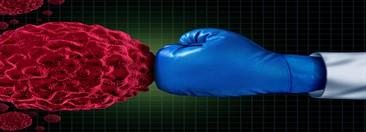Oncology is a branch of medicine that deals with the diagnosis and treatment of benign and malignant tumors. Oncological diseases relate to the uncontrolled proliferation of mutated cells within the body.
Why are malignant tumors dangerous?
As opposed to a benign tumor, a malignant tumor (otherwise known as a cancerous tumor) has a high level of mutagenicity and generates metastases which penetrate into vital organs, changing their structure and functions. Additionally, during tumor development there is a correspondent increase in blood toxin levels.

Which organs are vulnerable to oncological diseases, and what causes cancer?
Oncological diseases are systemic, and can therefore affect all the organs and systems of the body. Risk factors include genetic inheritance, gender, and age. This means that, the skin, lungs and digestive system is most at risk in young men, while older mens' prostates are more at risk. By contrast, young women are more likely to develop cervical, skin, digestive system, or lung tumors, while older women are most at risk from mammary gland diseases. Leukemia and lymphoma usually are detected in children.
It is worth mentioning that lung diseases have the highest lethality rate among all the oncological diseases regardless of gender and age.
The most common locations for oncological diseases to occur in men are:
- skin
- mammary gland
- trachea, bronchi, lung
- stomach
- large intestine
- prostate gland
- rectum, rectosigmoid junction and anus
- lymphoid and hematopoietic tissue
- uterine body
- kidney
- pancreas
- uterine cervix
- urinary bladder
- ovaries
The most frequent malignant tumors in men are:
- trachea, bronchi, lung tumors (usually at a young and middle age)
- prostate gland (the most common location in men of middle and old age)
- skin
- stomach
- large intestine
The most common locations for oncological diseases to occur in women are:
- breast cancer
- skin tumors
- uterine body
- large intestine
- stomach
- uterine cervix
- rectum, rectosigmoid junction, anus
- ovary
- lymphoid and hematopoietic tissue
- trachea, bronchi, lung
Malignant tumor statistics in children
Most commonly, hematopoietic and lymphoid tissue oncological diseases appear in children. Of all types of hemoblastosis, the most common is lymphoid malignancies.
What symptoms or signs do oncological diseases present?
In their early stages, oncological diseases most often proceed without visible clinical signs. The symptoms which necessitate a visit to the doctor manifest in later stages.
Most symptoms of oncological diseases are, unfortunately, general and nonspecific, meaning they often are difficult to detect. Sometimes, it is possible to identify local signs and complaints associated with organ damage in the region where the tumor is located.
General, non-specific symptoms include:
- General worsening of state
- Loss of appetite
- Weakness
- Decrease in immunity
- Fever
- Pain
- Idiopathic body weight loss
- Cough, voice changes, hoarseness
- Anemia
Local symptoms:
- Induration or swelling in one or another area
- Raise of moles / birthmarks
- Skin color change
- Lymph nodes enlargement
What diagnostic methods are used in oncology?
The greatest determinant of the success of treatments for cancer is its timely detection. Should you wish to monitor your health or have suspicious symptoms or complaints, Remed Health can organize an individually prepared examination in Turkey. This plan will be developed in cooperation with highly qualified specialists from the best clinics.
In oncology as well as many other areas of medicine, the process of diagnostics begins with simple methods and progresses towards complex, high-precision laboratory and instrumental methods. All results are analyzed with the patient's condition, symptoms and complains in mind.
The laboratory methods are:
- (complete, biochemical, hormones) blood tests
- cancer-specific markers and other specific tests
- AFP (alpha-fetoprotein)
- CEA (carcinoembryonic antigen)
- CA-125
- CA-15-3
- CA-19-9
- CA-242
- PSA
- Urine test
Endoscopic and radiological methods of investigation include:
- Colposcopy
- Bronchoscopy
- Fibrocolonoscopy
- EGD (fibrogastroduodenoscopy) and other endoscopic methods
Radiological diagnostics:
- Digital radiography, mammography (digital radiography of mammary glands)
- CT-diagnostics (computed tomography with or without contrast)
- MRI-diagnostics (magnetic resonance imaging)
- PET-CT diagnostics (positron emission tomography of the whole organism)
- Position emission tomography (PET) is a diagnostic method based on the use of radiopharmaceutical agents. The most commonly used of these agents are glucose particles (specifically, fluorodeoxyglucose, or F18-FDG), which is introduced intravenously. Tumor cells consume and accumulate glucose much more actively than normal tissues since tumor cells have a heightened metabolism. Therefore, the results of a PET-CT examination are determined by the distribution of glucose throughout the body. The indicators which might determine whether a PET-CT examination is required include a diagnosis of a malignant disease, the need for a re-assessment of an already determined malignant tumor due to the detection of metastases or the staging/re-staging of the tumor, the need to evaluate the effectiveness of a performed treatment, or the detection of indicators of tumor recurrence such as markers in the blood serum. PET-CT is also used to identify the primary tumor site (when additional metastases have been identified), to make a differential diagnostics of tumor recurrence and post-therapeutic changes, to schedule radiation therapy, and to determine the tumor site for biopsy planning.
- Ultrasonography-diagnostics
- Biopsy, cytological examinations, histological examinations of blood and tissues samples
Types of Cancer Treatment
Patients often perceive an oncological diagnosis as an incurable disease, but this is not true. Due to modern progress in early diagnostics and to the latest developed methods of treatment, most tumors, including malignant ones, are successfully treated. Successful treatment depends on the timely detection of the disease.
Treatment methods depend on the type of disease, its stage and course, location, the volume of the tumor, metastases, the patient's condition and on many other factors.
The advantages of oncological treatment in Turkey
Turkish clinics work to a global standard by using the best practices of Europe and the USA as well as their own innovations. Turkey is amongst the most sought after states for oncological treatments. Advantages of being treated in Turkey include:
The opportunity to detect cancer early and non-invasively, ultramodern equipment, A well-developed scientific-research medical infrastructure, the use of the most recent innovations in laboratory research, highly qualified doctors who are not only trained in Turkey but also in European countries and the USA, An excellent balance between quality and price, 50 medical institutions which are accredited by the JCI system, The high levels of care and kindness which Turkish medical personnel guarantee to all patients.
The method is based on the operative removal of the tumor and / or metastases.
Radiation treatment (radiotherapy) is carried out using X-rays and gamma rays of radioactive elements for fighting with cancer.
Treatment of cancer with the help of different chemo therapies is successfully carried out in Turkey.
There are many alternative options or therapies for your cancer treatment which is performed successfully in Turkey by medical specialists known in their field
You may get an alternative, treatment plan for your cancer treatment from the medical specialists of Massive Bio with which RemedHealth is working closely.





